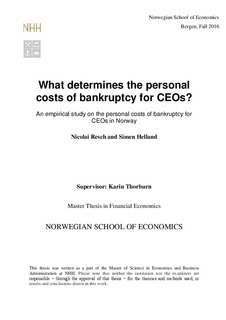What determines the personal costs of bankruptcy for CEOs? : an empirical study on the personal costs of bankruptcy for CEOs in Norway
Master thesis
Permanent lenke
http://hdl.handle.net/11250/2432527Utgivelsesdato
2016Metadata
Vis full innførselSamlinger
- Master Thesis [4372]
Sammendrag
This thesis is a study of personal costs of bankruptcy for CEOs in Norway. If these costs are
substantial, they can incentivize CEOs to hedge against bankruptcy. The practical
implications can be severe for the firms’ different stakeholders. We study a sample of 1,446
CEOs in 1,023 Norwegian firms declared bankrupt between 2009 and 2013. The thesis
comprises four main analyses examining personal costs in various forms: First, CEO
replacement incurs a personal cost in terms of reputational damage. As such, we analyze
determinants of CEOs´ replacements prior to bankruptcy. Second, those not attaining a new
CEO position after bankruptcy suffer costs in terms of lower status. Therefore, we address
the employment changes for our sample CEOs. Third, we address the compensation loss
imposed on the CEOs prior to bankruptcy. Fourth, we investigate compensation loss for
CEOs that occurs after the bankruptcy. These analyses are intended to give a profound
understanding of how CEOs in Norway are affected by bankruptcy.
We argue that the sum of CEOs´ personal costs of bankruptcy in Norway are sparse.
Consequently, we find no evidence to support the existence of CEO hedging behavior in
Norway. Compared with previous research, we find a relatively small share of CEOs being
replaced prior to bankruptcy (14% annually). Further, we observe a marginal reduction of
NOK 50 thousand in compensation prior to bankruptcy. In addition, we find a compensation
loss after bankruptcy for those not finding new employment as CEOs, but it only amounts to
NOK 536 thousand over their lifetime. However, we find that only a relatively small fraction
of our sample attains a new CEO position after bankruptcy (20%).
This thesis complements other research in Sweden and the U.S. on the same issue. Notably,
it is the first examination of Norwegian bankruptcies (and legislation). Under Norwegian
legislation, all bankrupt companies cease to exist. In both Sweden and the U.S. however,
firms can continue as a going-concern and sustain their business. Moreover, most larger
restructurings in Norway are settled in out-of-court negotiations and not registered, resulting
in a sample mostly consisting of small firms. These distinctions can also explain differences
in results between our study and previous research.
